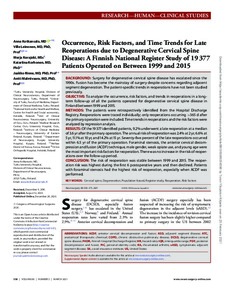Occurrence, Risk Factors, and Time Trends for Late Reoperations due to Degenerative Cervical Spine Disease: A Finnish National Register Study of 19 377 Patients Operated on Between 1999 and 2015.
Kotkansalo Anna; Leinonen Ville; Korajoki Merja; Korhonen Katariina; Rinne Jaakko; Malmivaara Antti
https://urn.fi/URN:NBN:fi-fe2021042825339
Tiivistelmä
Background
Surgery for degenerative cervical spine disease has escalated since the 1990s. Fusion has become the mainstay of surgery despite concerns regarding adjacent segment degeneration. The patient-specific trends in reoperations have not been studied previously.
Objective
To analyze the occurrence, risk factors, and trends in reoperations in a long-term follow-up of all the patients operated for degenerative cervical spine disease in Finland between 1999 and 2015.
Methods
The patients were retrospectively identified from the Hospital Discharge Registry. Reoperations were traced individually; only reoperations occurring >365 d after the primary operation were included. Time trends in reoperations and the risk factors were analyzed by regression analysis.
Results
Of the 19 377 identified patients, 9.2% underwent a late reoperation at a median of 3.6 yr after the primary operation. The annual risk of reoperation was 2.4% at 2 yr, 6.6% at 5 yr, 11.1% at 10 yr, and 14.2% at 15 yr. Seventy-five percent of the late reoperations occurred within 6.5 yr of the primary operation. Foraminal stenosis, the anterior cervical decompression and fusion (ACDF) technique, male gender, weak opiate use, and young age were the most important risk factors for reoperation. There was no increase in the risk of reoperations over the follow-up period.
Conclusion
The risk of reoperation was stable between 1999 and 2015. The reoperation risk was highest during the first 6 postoperative years and then declined. Patients with foraminal stenosis had the highest risk of reoperation, especially when ACDF was performed.
Kokoelmat
- Rinnakkaistallenteet [27094]
